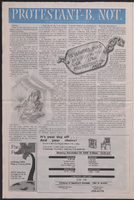Search the Special Collections and Archives Portal
Search Results
University of Nevada, Las Vegas ROTC Records
Identifier
Abstract
The University of Nevada, Las Vegas ROTC Records are comprised of administrative files and photographic prints from the University of Nevada, Las Vegas (UNLV) Army Reserve Officers Training Corps (ROTC) from its inception in 1980 to 1991. The collection includes photographs of cadet activities as well as Army ROTC recruitment materials.
Archival Collection
Aaron Williams Photograph Collection
Identifier
Abstract
The Aaron Williams Photograph Collection (approximately 1968 to 1983) consists of three black-and-white photographic prints. Two of the images are of the groundbreaking ceremony of the Senior Citizens’ Center with Las Vegas, Nevada Mayor Oran Gragson, and the third of three unidentified individuals.
Archival Collection
Harrah’s Entertainment Corporate Archives
Identifier
Abstract
The Harrah’s Entertainment Corporate Archives (dating from 1811 to 2004 with the bulk of the materials dating from 1940 to 2000) contain the promotional and corporate files of Harrah’s Entertainment Inc. and its predecessors, as well as Bill Harrah’s personal papers and card game collection. The materials were compiled and developed as a corporate archive by Harrah's Entertainment, Inc.’s Corporate Communications Department. The collection is primarily comprised of casino and employee periodicals, reports, manuals, promotional files, ephemera, and newspaper articles that document Bill Harrah’s casinos in Reno, Nevada and Lake Tahoe as well as Harrah’s Inc., Holiday Inns, Inc., Holiday Corporation, the Promus Companies, and Harrah’s Entertainment, Inc. Also included are photographs that document the construction of Harrah’s properties, business operations, the people who worked and performed at Harrah’s properties, and Bill Harrah’s automobile collection. The collection also contains Bill Harrah’s collection of playing cards and card games. Also included are photographs of the Harrah family.
Archival Collection

Meeting minutes for Consolidated Student Senate, University of Nevada, Las Vegas, September 27, 2004
Date
Archival Collection
Description
Text

Hildred Meidell interview, February 27, 1979: transcript
Date
Archival Collection
Description
On February 27, 1979, collector Greg Abbott interviewed Hildred Meidell (b. March 17, 1900 in Webb City, Missouri) about her time living in Las Vegas, Nevada. Meidell covers a range of topics, from her and her husband’s time as tourists in the city and their subsequent retirement to Las Vegas from Los Angeles, California. Meidell describes the Las Vegas Strip, the interstate and highway conditions between Los Angeles and Las Vegas, as well as their numerous visits to Hoover Dam (Boulder Dam). Moreover, she speaks about the changing layout of the city, the increase in shopping centers and department stores, and the clothing stores inside of hotels. Lastly, Meidell talks about the prominence of churches in local communities, the atomic testing program and the structural damages these tests caused in her neighborhood, and the influence of the railroad and passenger train on the town.
Text

Joseph C. Mattingly interview, February 23, 1979: transcript
Date
Archival Collection
Description
On February 23, 1979, collector Sean Powers interviewed Joseph C. Mattingly (born April 21st, 1912 in Texas) at his home in Las Vegas, Nevada. In this interview, Mr. Mattingly discusses working construction on many buildings in the Las Vegas and Henderson areas in Nevada. He also talks about being a member of a motorcycle club and about air conditioning in the early days.
Text

How does the Ivanpah solar electric generating station work? 2015
Date
Archival Collection
Description
Text
Alex Shoofey Papers
Identifier
Abstract
The Alex Shoofey Papers are comprised of records spanning 1967 to 1972 that primarily pertain to financial operations and policies for the International Hotel and Casino-Las Vegas Hilton and the Flamingo Hotel in Las Vegas, Nevada. The collection includes daily profit and loss reports, interdepartmental correspondence, staffing and operational policies and procedures, production reports, and Shoofey's personal correspondence. Collection materials are representative of business and financial records from Shoofey's tenure as president of both the International and Flamingo hotels and casinos.
Archival Collection
Samoset Chapter of the Colonial Dames XVII Century Records
Identifier
Abstract
The Samoset Chapter of the Colonial Dames XVII Century Records (1970-2022) consist of scrapbooks, volumes of meeting minutes and treasurer’s reports, and National Colonial Heritage Month proclamations from cities throughout Nevada. The materials document the Samoset (Las Vegas) Chapter’s activities, including chapter meetings, community service and events, gifts and scholarships, national and state conferences, and the chapter’s work to place a historic marker at Callville Bay, Lake Mead, Nevada.
Archival Collection

